Tyne Cot – The Largest Commonwealth Cemetery in the World
For the past two days Liberation Tour 2015 has been based in Ypres, Belgium where no less than five major battles were fought in WWI, encompassing a period from October 1914 to October 1918 – in other words, the whole bloody war. Canadians were involved from April, 1915 when they were victims of the first gas attack, at Mount Sorrel in 1916 where they held a vital position despite huge losses and most notably at Passchendaele in 1917, perhaps the bloodiest battle Canada has ever fought. It is impossible to know how many men died in this area over the course of the war, but it certainly was close to, if not more than, one million. Thankfully, other than a visit to relatively small Essex Farm Cemetery where John MacRae wrote In Flander’s Fields, we have not seen firsthand the ravages of war such as we witnessed at Cabaret Rouge Cemetery and Notre Dame de Lorette in the Somme. But, that is about to change as we pull up to the gates of Tyne Cot Cemetery not far from Ypres.
Tyne Cot Cemetery
On the way here tour historian Phil Craig tells us the history of Tyne Cot Cemetery which is a corruption of Tyne Cottage, a name given to a large barn in the area by British soldiers in 1917. It is now the largest Commonwealth Cemetery in the world with close to 12,000 graves of which an incredible 8,369 are unidentified. If that’s not horrific enough, the Tyne Cot Memorial on the same site commemorates another 35,000 who were killed at Passchendaele and whose remains were never found. Think about this; of 47,000 men and boys who died here from 1917 on we can only identify less than 10% of them. If that doesn’t tell you what heavy artillery, mines and massed machine gun fire can do to a body, nothing will. For all intents and purposes these soldiers were physically and psychically disintegrated.
I’ve been visiting war graves all over the world for over fifty years, but I still get a knot in my stomach each time I head to the entrance and Tyne Cot Cemetery is no different. However, upon passing through this entrance gate with the Cross of Sacrifice directly ahead and the graves symmetrically arranged on all sides, a feeling of calm comes over me and the dread goes away, as it always does.
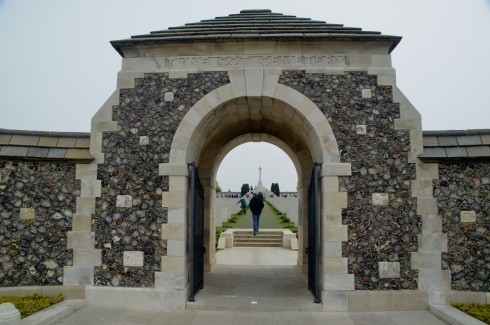
My first task is to check the register for any Dunlops interred at Tyne Cot and there are two, whose graves I seek out. This is Charles Reginald Dunlop from Chatham, Ontario, son of Charles H. and Nettie May Dunlop. He died on the first day at Passchendaele.
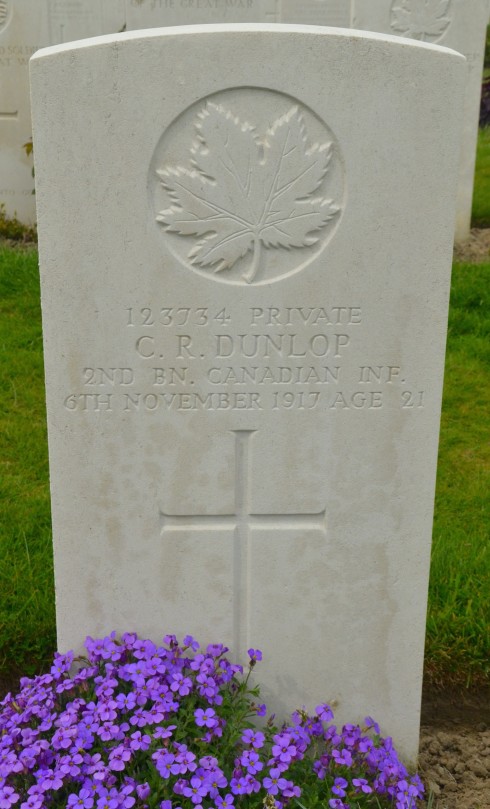
And this is Henry Dunlop, son of David and Annie Dunlop of Belfast, Northern Ireland which is where my grandfather emigrated from in the late 1800’s. Henry may well have been a relative. He died in the fighting at Passchendaele before the Canadians arrived.
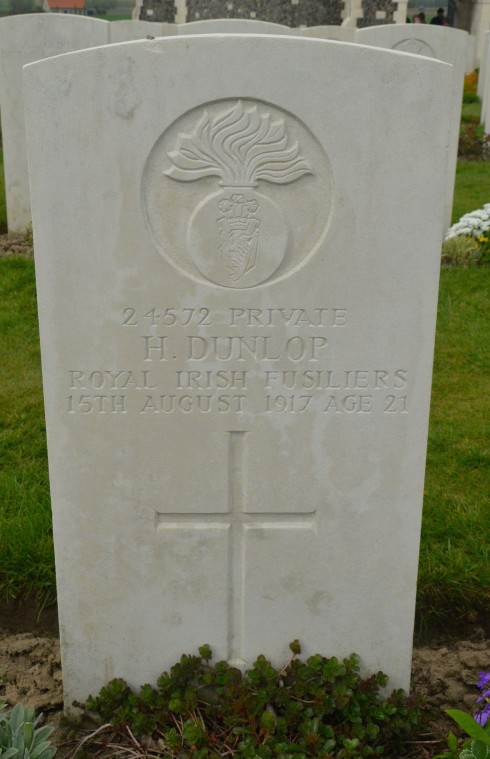
There are some Victoria Cross recipients in Tyne Cot as well. This is James Peter Robertson of the Royal Winnipeg Rifles who was born in Pictou County, Nova Scotia before moving west. Here he is in life.
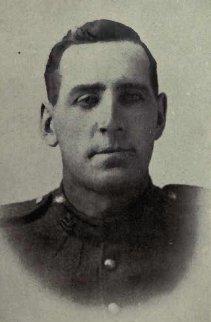
And death. As you can see from the crosses, he has not been forgotten.
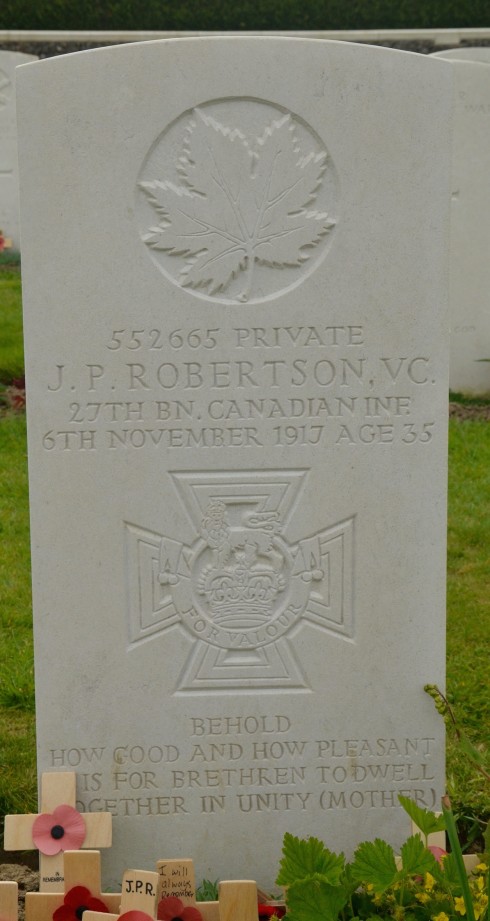
This is his citation:
“For most conspicuous bravery and outstanding devotion to duty in attack. When his platoon was held up by uncut wire and a machine gun causing many casualties, Pte Robertson dashed to an opening on the flank, rushed the machine gun and, after a desperate struggle with the crew, killed four and then turned the gun on the remainder, who, overcome by the fierceness of his onslaught, were running towards their own lines. His gallant work enabled the platoon to advance. He inflicted many more casualties among the enemy, and then carrying the captured machine gun, he led his platoon to the final objective. He there selected an excellent position and got the gun into action, firing on the retreating enemy who by this time were quite demoralized by the fire brought to bear on them.
During the consolidation Pte Robertson’s most determined use of the machine gun kept down the fire of the enemy snipers; his courage and his coolness cheered his comrades and inspired them to the finest efforts.
Later, when two of our snipers were badly wounded in front of our trench, he went out and carried one of them in under very severe fire.
He was killed just as he returned with the second man”.
Private Robertson was thirty-five when he did what he did, no doubt a man among many boys.
When I wrote earlier in this post about the consequences to the human body of being hit by an artillery shell or being exploded by a mine, this is what I meant. Here are five unidentified Canadians in one grave at Tyne Cot.
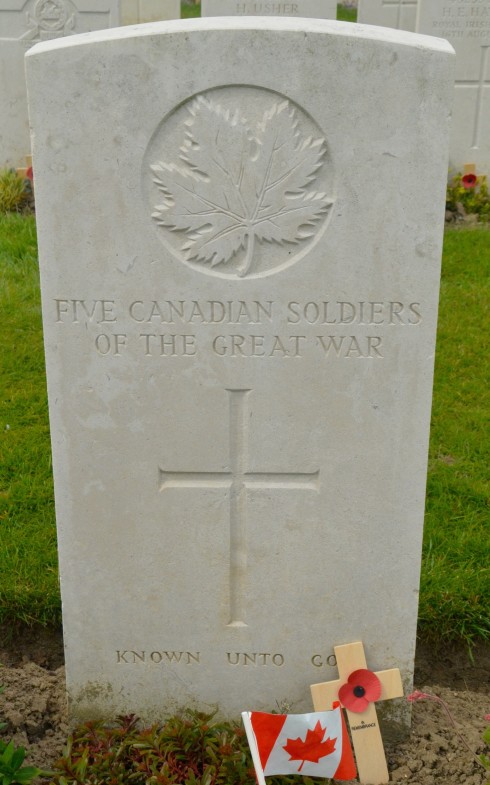
And despite the inscription there was nothing remotely ‘great’ about this war.
This is the Tyne Cot Memorial with a few of the 35,000 + names of the missing.

As I mentioned you can see the Cross of Sacrifice as you enter the cemetery. On the website there is this admonition in capitol letters:
SCHOOL GROUPS: TEACHERS – PLEASE CLOSELY SUPERVISE YOUR STUDENTS, PARTICULARLY AT THE TYNE COT CEMETERY CROSS OF SACRIFICE
So obviously they do not want school students disrespecting the memory of those who gave the ultimate sacrifice, by climbing all over the monument. This is what I saw when I got there.
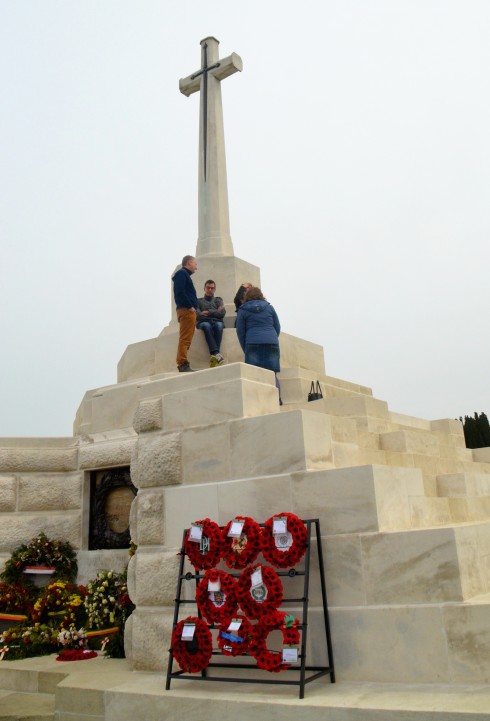
These were not students, but adults who should have know better. I felt like climbing up and kicking the asshole with his hands in his pockets right in the nuts, but that would have been disrespectful too.
Tyne Cot is the last WWI site we will visit on the Liberation Tour 2015 and I am not sorry that it is. This so-called ‘War to end all Wars’ of course did not and in fact sowed the seeds for an even worse one to come in terms of total deaths. It was to me the most incomprehensible event in western history – a slaughter so great and for so long that it simply defies any understanding from my perspective a century on. However, we can and should never forget that the thousands upon thousands of young men and boys’ whose graves, known and unknown, we have visited on this trip, were not the ones responsible. In Masters of War, I think Bob Dylan wrote just about exactly how I feel about WWI. He later said he felt bad about the outright expression of hate that is conveyed in the song, but I don’t. I think he got it right. To paraphrase another one of Bob’s songs, these boys were ‘only a pawn in their game’.
“Masters Of War”
You that build all the guns
You that build the death planes
You that build all the bombs
You that hide behind walls
You that hide behind desks
I just want you to know
I can see through your masks.You that never done nothin’
But build to destroy
You play with my world
Like it’s your little toy
You put a gun in my hand
And you hide from my eyes
And you turn and run farther
When the fast bullets fly.Like Judas of old
You lie and deceive
A world war can be won
You want me to believe
But I see through your eyes
And I see through your brain
Like I see through the water
That runs down my drain.You fasten all the triggers
For the others to fire
Then you set back and watch
When the death count gets higher
You hide in your mansion’
As young people’s blood
Flows out of their bodies
And is buried in the mud.You’ve thrown the worst fear
That can ever be hurled
Fear to bring children
Into the world
For threatening my baby
Unborn and unnamed
You ain’t worth the blood
That runs in your veins.How much do I know
To talk out of turn
You might say that I’m young
You might say I’m unlearned
But there’s one thing I know
Though I’m younger than you
That even Jesus would never
Forgive what you do.Let me ask you one question
Is your money that good
Will it buy you forgiveness
Do you think that it could
I think you will find
When your death takes its toll
All the money you made
Will never buy back your soul.And I hope that you die
And your death’ll come soon
I will follow your casket
In the pale afternoon
And I’ll watch while you’re lowered
Down to your deathbed
And I’ll stand over your grave
‘Til I’m sure that you’re dead.
Since I first posted this story I received a lot of flak from readers who didn’t agree with me that climbing the Memorial was disrespectful. We have had a lively and respectful discussion and I don’t think anyone’s opinion has been changed, but I’m glad it has sparked interest in Tyne Cote Cemetery.
The next post will be a purely personal one as Alison and I deviate from the Liberation Tour itinerary to visit the grave of an uncle she never met at Calais Canadian War Cemetery. You are welcome to come along.

